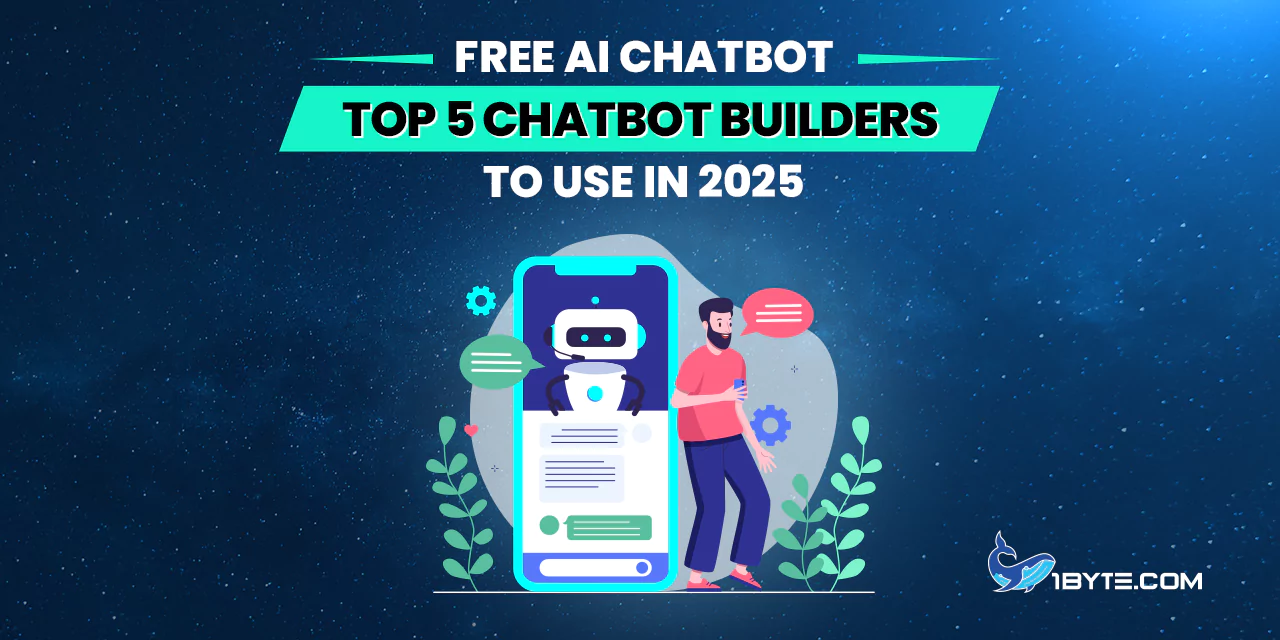Chatbots have evolved from niche novelties into mainstream business tools by 2025. In fact, about two-thirds of consumers have interacted with a chatbot in the past year, and an overwhelming 96% of consumers think companies should use chatbots for customer support. On the business side, 80% of sales and marketing leaders have implemented or plan to integrate chatbots into customer interactions. This surge is driven by advances in AI – gone are the days when building a bot required extensive coding. Today’s chatbots are intelligent, versatile, and easy to handle, revolutionizing not just customer service but also marketing, HR, and more. Many platforms now let you create a chatbot with little to no coding, often at no cost. If you’re looking to build a free AI chatbot for general purposes (beyond just simple FAQ or e-commerce bots), there are excellent options available. Below we at 1Byte explore the top 5 free AI chatbot builder platforms in 2025 that offer free access or trials, robust features, and integration with popular services like WhatsApp, Messenger, Slack, CRMs, and websites.
1. ManyChat
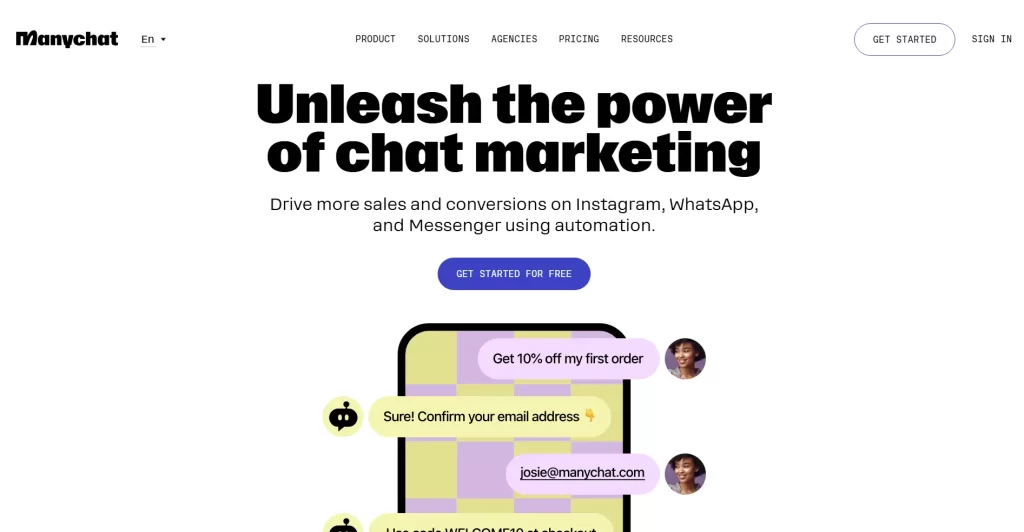
ManyChat is a widely-used chatbot platform known for its user-friendly, no-code interface and focus on social messaging channels. It allows businesses to create interactive chatbots on Facebook Messenger, Instagram Direct, and even WhatsApp without programming. ManyChat’s strength lies in enabling engaging conversations for everything from customer support to marketing campaigns. Its drag-and-drop visual flow builder and library of templates make bot creation quick and accessible to non-developers.
Free Plan
ManyChat offers a free plan that supports up to 1,000 contacts and core features. On the free tier, you can deploy chatbots on Facebook Messenger, Instagram, and WhatsApp – covering the most popular messaging apps. (SMS and email integrations are available on paid plans.) This means a small business can start automating chats on social media at no cost. The free plan includes basic broadcasting, automated conversation flows, and audience segmentation tools to engage users.
Key Features
- Multi-Channel Automation: Design one chatbot and use it across Messenger, Instagram DMs, and WhatsApp to reach customers on their preferred platform. For example, you can greet a new Instagram follower with a chatbot message or answer FAQs on your Facebook page messenger.
- Visual Flow Builder: ManyChat’s intuitive editor lets you map out conversation paths with drag-and-drop blocks. You can create menus, ask questions, save user responses, and set up keywords without any coding.
- Rich Media & Interactive Elements: Bots can send images, carousels, videos, and even Quick Reply buttons to make chats engaging. For instance, a restaurant’s bot can show a menu carousel and take reservations via chat.
- Templates and Growth Tools: ManyChat provides pre-built templates for common use cases (like appointment booking or lead generation) and growth tools to capture users (e.g. embedding a “Chat with us” widget on your website).
- AI Integration: While ManyChat started as a rule-based builder, it now allows integration with AI services. Users can connect ManyChat with OpenAI’s ChatGPT via external requests or third-party integrations to give their chatbot more free-form conversational abilities. This means your bot can hand off complex questions to an AI for a more natural answer, then continue the structured flow.
Use Cases
ManyChat is ideal for small to medium-sized businesses aiming to engage customers on social media. It’s popular for marketing automation – for example, a retail brand can use ManyChat to run an Instagram giveaway, then have the chatbot automatically message participants with a discount code. It’s equally useful for customer support inquiries that come through Facebook or IG. With WhatsApp integration, businesses can also automate FAQs and notifications (like order updates) on the world’s most popular chat app. ManyChat’s strength is its accessibility – you can set up a welcome chatbot for your Facebook page in minutes, without technical help. Its visual builder and templates enable quick deployment of bots that can handle tasks from answering simple questions to collecting user info for leads.
2. Landbot
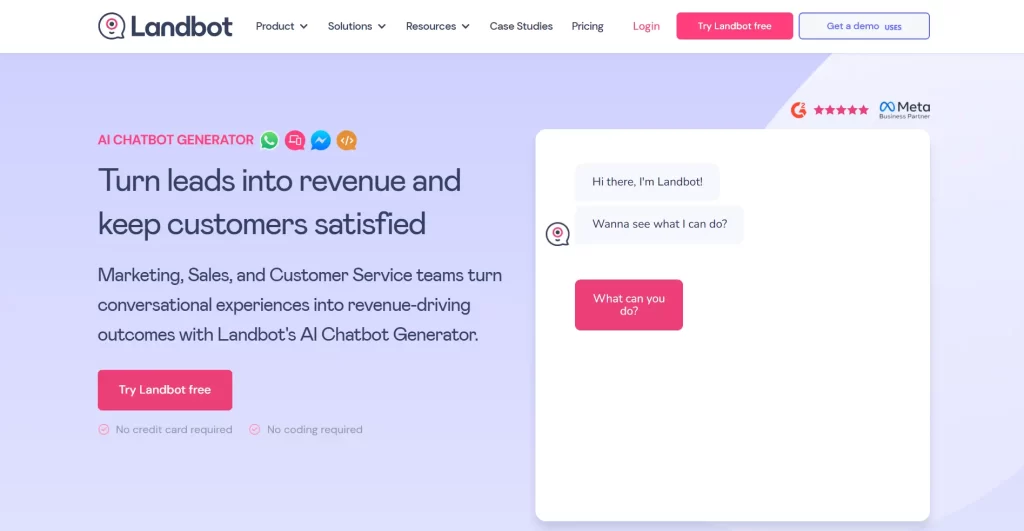
Landbot is a no-code chatbot platform that specializes in rich web chat experiences. It allows you to create highly interactive chatbots that can be embedded on websites or used in web apps and WhatsApp. Landbot stands out for its conversational design – the chatbots simulate a messaging app-style interface on your site, which can be far more engaging than traditional forms. Landbot’s free version (the “Sandbox” plan) is free forever and lets you test its core features on a small scale (up to 100 chats per month). This makes it a great starting point for businesses to experiment with web chatbots for lead generation or customer service.
Key Features
- Drag-and-Drop “Blocks” Builder: Landbot uses a block-based visual builder where each block represents a message, question, or logic jump. Designing a conversation feels like creating a flowchart – you can easily craft complex dialogs with conditions (if/then logic) and user input without coding.
- Interactive Elements: Landbot bots can collect information through buttons, quick replies, forms, and even embed videos or images in the conversation. This lends well to use cases like quizzes, surveys, or guided product finders. For example, a Landbot on a travel site could ask a series of questions (destination, budget, dates) and then suggest packages.
- Website and WhatsApp Integration: The platform originally gained fame for website chatbots, and it provides a snappy, customizable chat widget for any webpage. It also offers integration with WhatsApp Business API, so you can deploy the same bot on WhatsApp to chat with users there (available on paid plans). Facebook Messenger integration is supported as well (from the paid “Starter” plan up). This multi-channel support means you can design a conversation once and deliver it on web, messaging apps, or even via direct link.
- Templates and Use-Case Library: Landbot provides templates for common flows like lead generation, FAQ, feedback collection, and e-commerce. You can start from a template (say, a lead capture bot) and customize the questions to suit your business, speeding up development.
- Integration and APIs: For more advanced needs, Landbot can connect to other apps through integrations or webhooks. It has native integrations for tools like MailChimp (to add captured emails to a list) as one user noted, and you can use Zapier or API calls to send data to your CRM or database. This is useful if you want your chatbot to, for instance, create a support ticket in Zendesk or fetch information from your backend.
Use Cases
Landbot is particularly popular for lead qualification and interactive marketing. Many businesses embed a Landbot on their homepage as an interactive concierge that welcomes visitors and guides them – essentially replacing static web forms. “I’ve used it on my website to qualify leads – in place of a contact form,” one user review notes, highlighting that building a bot is “super easy” and effective at engaging users. You can similarly use Landbot for customer onboarding (walking users through steps or FAQs in a friendly chat manner) or surveys and feedback collection. On WhatsApp, Landbot can automate customer communications for companies that have customers messaging for inquiries – for example, an appointment-based business could have a WhatsApp bot to schedule bookings. With its free sandbox and playful interface, Landbot is a great general-purpose chatbot builder when you want a more conversational touch on the web or across channels.
3. Tidio
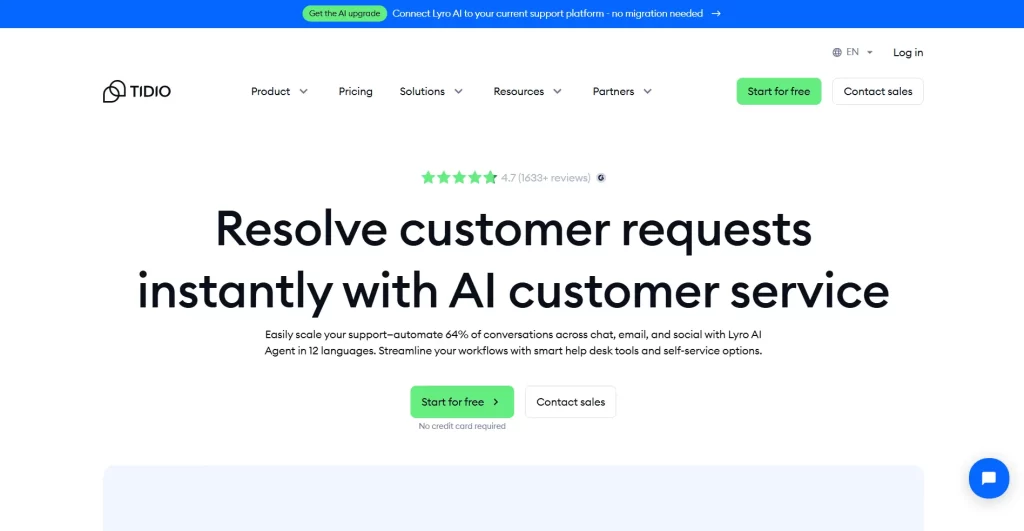
Tidio is a platform that combines live chat, chatbots, and email integration into one unified inbox, making it a powerful solution for small businesses and e-commerce websites. Tidio’s chatbot builder allows you to automate responses and workflows, while still seamlessly handing off to human agents via live chat when needed. One of Tidio’s big advantages is its free forever plan – you can use live chat and basic chatbot functionality indefinitely without charge, which is ideal for startups and personal sites. Tidio also keeps things simple for non-technical users: it offers a visual editor and a rich template library so you can set up a bot with just a few clicks.
Key Features
- Omnichannel Inbox: Tidio integrates with platforms like email and Facebook Messenger, allowing you to receive and respond to messages from multiple channels in one dashboard. For example, if a customer sends a question via your website chat widget or via Messenger, you’ll see both in Tidio’s inbox. You can even reply to emails from the same interface. This unified experience is a huge time-saver and ensures no customer inquiry slips through the cracks.
- Visual Chatbot Editor: Like others, Tidio provides a drag-and-drop editor to create chatbot flows. You can design triggers (e.g. when a user opens the site or after 30 seconds of inactivity) and actions (send a message, ask a question, etc.). Pre-designed chatbot templates are available for scenarios such as lead generation, greeting new visitors, recovering abandoned carts, or answering FAQs. If you run an online store, you might use a template that automatically offers help when someone stays on a product page too long.
- AI and NLP Capabilities: In 2024, Tidio introduced “Lyro,” an AI-powered chatbot that can learn from your website content and FAQ to answer questions automatically. This generative AI feature means even the free plan users can deploy a bot that handles complex customer queries in a conversational way. The technology leverages large language models to understand user questions and craft answers from your knowledge base. As a result, even a small shop can provide instant, accurate answers 24/7, improving customer experience.
- E-commerce Integrations: Tidio offers dedicated integrations and plugins for Shopify, WordPress, and WooCommerce, making installation plug-and-play. It can also integrate with CRM and marketing tools via Zapier. Tidio’s Shopify plugin, for example, can track cart contents – enabling your chatbot to proactively assist with cart recovery (e.g., “Need help with checkout? Here’s a 10% off coupon!”).
- Live Chat Handoff: What sets Tidio apart is the smooth handoff between chatbot and human support. You can configure rules such that the bot answers common questions but if it detects something it can’t handle (or a user requests a human), it notifies a live agent. Agents using Tidio see the conversation history and context, so they can jump in seamlessly. This ensures the personal touch is there when needed, while the bot filters out routine tasks.
Use Cases
Tidio is a top choice for customer service and sales on websites. Imagine a small online boutique: Tidio’s chatbot can greet visitors with “Hello! Let us know if you have any questions 🙂,” answer queries about order tracking or return policy automatically, and even recommend products (via predefined flows or AI). If a customer types something the bot isn’t sure about, it can ping the store owner or support rep to join the chat live. This hybrid approach can improve response times and customer satisfaction, which is crucial given that 82% of consumers would use a chatbot if it saves them waiting for a human rep. Besides support, businesses use Tidio’s bots for marketing automation – such as collecting email addresses with a friendly prompt (“Want a 10% discount? Just drop your email here!”) or sending follow-up messages. Overall, Tidio provides a well-rounded free chatbot solution with plenty of room to grow via its paid features, all while integrating with the everyday tools businesses use.
4. Botpress
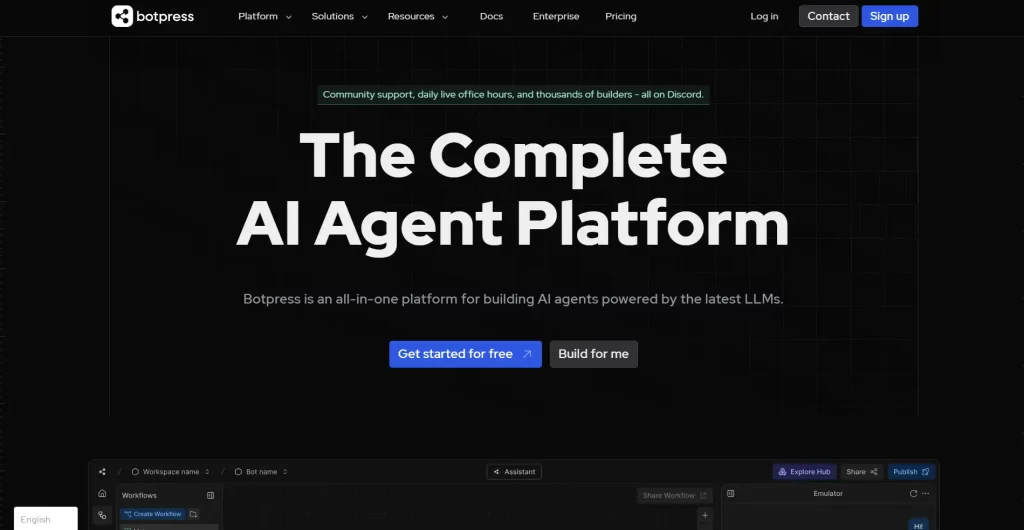
Botpress is a powerful open-source chatbot builder that has grown into a full-featured platform for creating AI chatbots. It’s geared towards developers and companies that need flexibility, but it also offers an intuitive interface that non-coders can use. Botpress stands out for its advanced AI capabilities (including natural language understanding and integration of large language models) and its ability to be self-hosted or cloud-hosted. In 2025, Botpress offers a generous free tier under a pay-as-you-go model: you can create up to 5 chatbots with 2,000 messages per month at no cost. This free plan even includes some monthly AI credits and vector database storage for knowledge base integration, which means you can build a pretty sophisticated AI assistant without paying a cent until you scale up.
Key Features
- Hybrid Code/No-Code Builder: Botpress provides a visual conversation builder where you can design flows and responses, as well as a built-in code editor for custom actions. This is ideal for teams with mixed skill sets – a conversation designer can lay out the dialogue, and a developer can drop in JavaScript code if needed for advanced logic or API calls. The platform supports defining intents, entities, and slots to handle natural language inputs, much like Dialogflow or other NLP engines.
- Multi-Channel Deployment: Chatbots built with Botpress can be deployed across a wide range of channels. The platform actively maintains integrations with popular messaging services including Facebook Messenger, Slack, Microsoft Teams, and Telegram. Additionally, you can connect bots to web chat widgets or any channel via APIs. This means your Botpress bot can converse on your website’s chat, respond to employees on Slack, and handle Facebook messages – all using the same brain. Such omnichannel support is critical as businesses increasingly want to use one AI agent across multiple platforms.
- 100+ Language Support: Out of the box, Botpress offers translation and natural language understanding in over 100 languages. If you operate in multilingual markets or have a global audience, Botpress can detect and converse in the user’s language, making it extremely versatile for international use cases.
- Enterprise-Grade Features: Even though Botpress can be used for free, it includes features designed for enterprise usage. This includes security compliance (GDPR, SOC 2), role-based access control for team collaboration, and analytics dashboards. It also has an extensions system and integrates with tools like Jira, Notion, HubSpot and more, which is useful if you want your chatbot to interact with internal data or business workflows. For example, a Botpress bot could be set up to create a Jira ticket when a user reports an IT issue through chat.
- AI and Knowledge Base Integration: Botpress has kept pace with the generative AI trend. It offers a built-in vector database to store your documents or FAQs and free AI credits each month on the free plan, which can be used to query language models. In practical terms, you can give your Botpress chatbot a bunch of company knowledge (product manuals, help center articles) and the bot can answer user questions by retrieving and summarizing that info – a technique known as Retrieval Augmented Generation (RAG). This allows for more intelligent, context-aware responses rather than just scripted answers.
Use Cases
Botpress is a great fit when you need a custom AI chatbot that might go beyond what typical drag-and-drop platforms allow. It’s used by businesses for everything from customer support bots to employee-facing assistants. For instance, a company could deploy a Botpress chatbot on Slack to act as an HR assistant that employees can ask about policies, benefits, or PTO balance – the bot could pull answers from an internal wiki. At the same time, that company could have a customer-facing bot on their website answering support questions, all powered by the same Botpress backend. The platform’s flexibility also makes it suitable for building voice assistants or IoT device assistants if needed (since you can process inputs and outputs in many forms). With the free tier, a developer could prototype a sophisticated bot that uses GPT-4 for language and integrates with say, a database of user orders, to create a concierge that can answer “Where’s my order?” type questions accurately. Botpress requires a bit more learning curve than simpler tools, but it offers maximum control and AI power, which is why it’s recognized as a top platform for 2025.
5. IBM Watson Assistant (Watsonx Assistant)
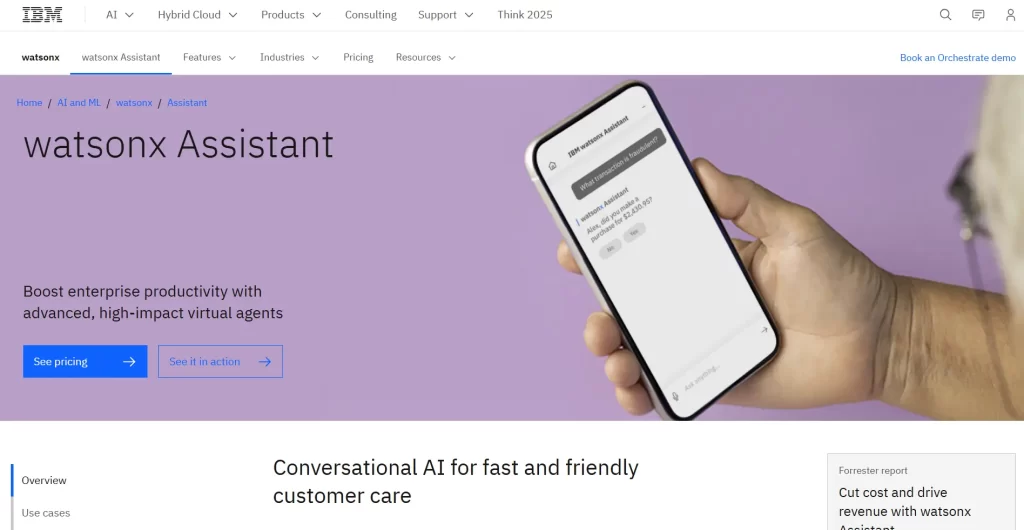
IBM’s Watson Assistant is a leading AI chatbot platform known for its strong natural language understanding and enterprise-grade capabilities. Backed by IBM’s years of AI research, Watson Assistant can handle complex dialogues and integrate with various business systems. Despite its power, it’s accessible to smaller teams thanks to a Lite plan that is free to use, which allows anyone to try building a chatbot with Watson’s AI engine. In 2024, IBM rebranded some of its AI offerings under “watsonx”, and Watson Assistant has incorporated new generative AI features to stay at the cutting edge. It’s a general-purpose platform – you can deploy Watson Assistant on your website, mobile app, or messaging channels, and train it for use cases ranging from IT helpdesk to banking customer service.
Key Features
- Advanced NLP and Dialog Management: Watson Assistant uses IBM’s proprietary natural language processing to understand user queries (intents) and entities. It supports multi-turn conversations, meaning it can ask clarifying questions and handle context across a dialogue. For example, if a customer says “I need to reset my password,” the bot can step through a process, then if the user says “Actually I forgot my username,” it understands the context and adjusts. The system also allows for digressions (users changing topic mid-conversation) and can return to finish a task, providing a very natural experience.
- Visual Dialog Builder: Though IBM’s tech is sophisticated, building a chatbot doesn’t require coding. Watson Assistant provides a GUI to define intents, example phrases, and dialog flows. You can easily create if-else logic, slot filling (collecting multiple pieces of info), and integrate with external APIs via webhooks. There are also pre-built content libraries (“skills”) for common topics like small talk, greetings, or handling out-of-scope questions, which you can plug into your bot to speed up development.
- Generative AI Integration: In the latest version (watsonx Assistant), IBM has introduced what they call “trusted generative AI” capabilities. This allows the assistant to use large language models for formulating answers in a safe, controlled manner. Essentially, you can have Watson Assistant search a knowledge base or connect to IBM Watson Discovery, and then have an AI model generate an answer in natural language. IBM emphasizes “guardrails” and clarity with this feature, given enterprise demands for accuracy. This generative feature is great for answering open-ended questions where a scripted answer might not exist – for example, summarizing a product document for a customer inquiry.
- Multi-Channel and Integration Support: Watson Assistant can be deployed on a variety of channels out-of-the-box. It integrates with Slack, Facebook Messenger, WhatsApp, phone/SMS (via Twilio), Microsoft Teams, and more. It also has a web chat plugin you can embed on your site with a snippet of code. Additionally, Watson Assistant can connect to CRM systems like Salesforce or Zendesk to log conversations or pull in customer data. This broad integration means your bot can exist wherever your users are. For example, you could have the same banking chatbot on your website’s chat, on your mobile app, and on WhatsApp for quick queries – all syncing to your CRM.
- Analytics and Training Tools: IBM provides robust analytics to monitor your chatbot’s performance – you can see metrics like containment rate (how many inquiries the bot handled without human intervention) and identify drop-off points in conversations. There are also tools for human agents to monitor live chats and take over if needed. Over time, Watson Assistant lets you improve the bot by analyzing real conversations and suggesting new intents or utterances that the AI didn’t understand, thus continuously improving accuracy.
Use Cases
Watson Assistant is used across many industries – banking, healthcare, retail, government, insurance, you name it. Its ability to handle sensitive data and comply with security standards (it’s HIPAA-ready, GDPR compliant, etc.) makes it a trusted choice for enterprise deployments. For example, a hospital might use Watson Assistant to power a patient chatbot that answers questions about clinic hours or checks symptoms and provides advice, escalating to a human nurse chat when necessary. In an enterprise IT setting, Watson can serve as a tech support bot, resetting passwords or guiding employees through troubleshooting steps. One of the big appeals of Watson Assistant is that it can automate a lot of interactions while still providing a path to human agents and integrating with existing systems. And you don’t have to be a Fortune 500 to use it – with the free Lite plan and cloud-hosted service, even a small business can build a prototype chatbot that leverages IBM’s AI for free. As needs grow, the Plus plan can scale to production usage. In short, IBM Watson Assistant is a top-tier AI chatbot builder platform for 2025, offering a mix of power, integrations, and reliability that’s hard to beat in mission-critical applications.
Leverage 1Byte’s strong cloud computing expertise to boost your business in a big way
1Byte provides complete domain registration services that include dedicated support staff, educated customer care, reasonable costs, as well as a domain price search tool.
Elevate your online security with 1Byte's SSL Service. Unparalleled protection, seamless integration, and peace of mind for your digital journey.
No matter the cloud server package you pick, you can rely on 1Byte for dependability, privacy, security, and a stress-free experience that is essential for successful businesses.
Choosing us as your shared hosting provider allows you to get excellent value for your money while enjoying the same level of quality and functionality as more expensive options.
Through highly flexible programs, 1Byte's cutting-edge cloud hosting gives great solutions to small and medium-sized businesses faster, more securely, and at reduced costs.
Stay ahead of the competition with 1Byte's innovative WordPress hosting services. Our feature-rich plans and unmatched reliability ensure your website stands out and delivers an unforgettable user experience.
As an official AWS Partner, one of our primary responsibilities is to assist businesses in modernizing their operations and make the most of their journeys to the cloud with AWS.
Conclusion
Chatbots are no longer a luxury for big companies – they’ve become an essential tool for businesses of all sizes, and the options for building one have never been more accessible. The top 5 free chatbot builders we’ve covered – ManyChat, Landbot, Tidio, Botpress, and IBM Watson Assistant – each offer a unique mix of features suited to different needs. Whether you want to engage social media followers, capture leads on your website, streamline customer support, or create a sophisticated AI assistant, there’s a platform here that can likely do the job without upfront costs. All of these solutions support integrations with popular channels like Messenger, WhatsApp, and Slack, so your chatbot can meet your audience wherever they are.
When choosing a chatbot platform, consider your specific use case and growth plans. For example, if you’re focused on Instagram and Facebook engagement, ManyChat’s specialized tools and free plan are very appealing. If you need a conversational form on your website or a WhatsApp bot, Landbot offers a playful yet powerful interface. Tidio is excellent for a blended live chat + chatbot approach on an online store, ensuring customers get instant answers and human help as needed. Botpress is the go-to if you anticipate needing deep customization or want to leverage open-source flexibility and advanced AI from the start. And for those who need an enterprise-grade solution or see themselves expanding the chatbot’s role significantly, IBM’s Watson Assistant provides a future-proof path from a free trial to a robust deployment.

